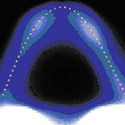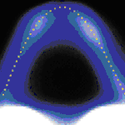Making room for holes
binary compounds have been extensively studied for their thermoelectric properties. Although primarily and also are more commonly used as thermoelectric materials, they have recently begun to attract attention due to the promise of hosting so-called topological surface states.
One of the major issues for both thermoelectric applications and fundamental research on topological phases in Bi2Se3 is creating a hole-doped variant of this material. Pure Bi2Se3 exhibits n-type behavior due to the presence of selenium vacancies that act as electron donors, but hole-doping is much more difficult.
Writing in Physical Review B, Yew San Hor and collaborators from Princeton University report that they have managed to dope holes into Bi2Se3 by substituting calcium for bismuth. Scanning-tunneling microscopy reveals that the calcium donates holes that compensate the electrons created by the selenium vacancies.
Angle-resolved photoemission spectroscopy in turn reveals that the hole-doping substantially lowers the Fermi level in Bi2Se3 with respect to that of pure Bi2Se3. In order to access topological surface states, it is necessary to be able to tune the Fermi level, which should be possible in this material. The hole-doped material also exhibits intriguing transport anomalies at low temperatures that are currently not understood. – Alex Klironomos





